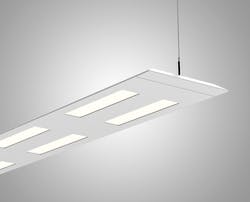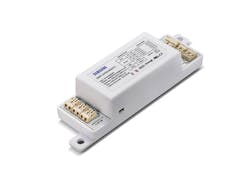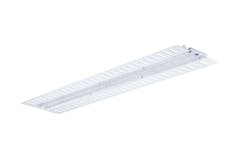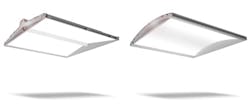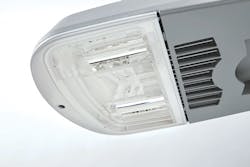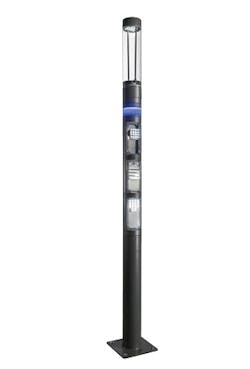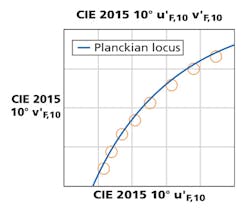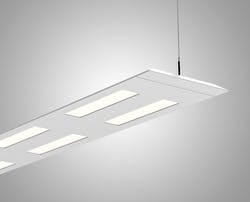Networks and smart lighting remained in the spotlight at LightFair 2016, but MAURY WRIGHT reports that lighting designers and specifiers may still care more about the quality of LED-based products than value-added, lighting-centric features.
LightFair International (LFI) 2016 took place during the last week of April, moving the West Coast venue to San Diego, CA for the first time, but still attracting more than 25,000 registrants to the coastal setting. The predominant theme at the event was the same networked-lighting story and concept of new services and applications that dominated the earlier Strategies in Light (SIL)/The LED Show and Light+Building (L+B) shows. Exhibitors at LFI, however, seemed less certain as to what exactly lighting designers and specifiers will pay a premium for in terms of intelligence, connectivity, and the movement toward solid-state lighting (SSL) as a key cog in the Internet of Things (IoT) movement. Make no mistake, though: Those specifiers want higher-quality LED-based lighting with more lighting-centric features, and the SSL industry is moving to address those demands from enabling components to lamps and luminaires.
Interested in articles & announcements on LED lighting?
It's unclear as to whether the specifier community is lukewarm on the tenets behind smart lighting, whether the dizzying number of connectivity options is keeping them on the sidelines, or if the IoT movement just needs a bit more age and maturity like a fine wine. Consider Samsung, who supplies LED components and other enabling technologies to LED lighting product developers. Going back to LFI a year ago, the company charted a course forward to enabling network controls. The company just rolled out its modular approach to networked lighting at L+B 2016 and that product was featured in its LFI exhibit as well (Fig. 1). Jacob Tarn, executive vice president of the Samsung LED Business Unit, has insisted all along that the chronology of its smart SSL activity was plenty early for the company to establish a play supplying mainstream lighting manufacturers. And we asked Tarn about the Power-over-Ethernet (PoE) connectivity scheme that has garnered headlines in the last year. Tarn insisted that the broad lighting market is not yet ready for PoE technology.
The prevalent message seems to be that while we have noted the benefits of networked control for years, it remains an early adopter market. Not so for LED light sources, which were really the only game in town at LFI and at other major lighting exhibitions in the recent past. But specifiers are demanding more in terms of quality, feature set, and overall product performance. Moreover, luminaires designed for a specific purpose have become common and almost required of lighting manufacturers.
Healthcare and retail
Consider the products displayed by Hubbell Lighting at LFI. One interesting example is the Remedi luminaire designed for use in medical facilities to light a patient room, which is due for formal introduction and sale this summer. The linear luminaire is designed to be mounted on the wall above the patient bed. But while most such patient rooms have multiple types of lighting in the room, the Remedi is intended to serve all primary lighting needs in the room.
FIG. 1. Samsung's Smart Lighting Module allows SSL product developers to accelerate time to market while adding networked controls to products.
Hubbell's developers accomplished the multifunction design by integrating three separate light engines and optical compartments, each of which runs the length of the fixture. The compartment on the top side of the luminaire provides indirect ambient light off the wall and ceiling. The compartment on the bottom of the fixture delivers reading light for the patient. And an angled compartment on the side of the luminaire throws light the length of the bed and supplies sufficient light for exams. Hubbell said the exam light can deliver more than 100 fc on the bed surface. And the company will offer a choice of CCT for the ambient light and the option for tunable white color that will enable human-centric lighting (HCL) functionality with warmer light at night and cooler light in the morning.
Moving to a drastically different application, Hubbell showed the Megaplane (MPL) linear mid-/high-bay luminaire from its Columbia Lighting brand (Fig. 2). The product is designed specifically for retail and industrial applications where a fixture is needed to light both sides of an aisle as opposed to lighting the aisle itself. To accomplish the task at hand, Hubbell's engineers developed total internal reflection (TIR) optical elements that are oriented perpendicular to the length of the product and spaced at even intervals along that length. The elongated oval optic creates a rectangular light pattern and can be ordered in narrow or wide distributions. Moreover, Hubbell offers 90 CRI as an optional feature that might be needed in some retail applications to render merchandise accurately.
Another newcomer to the SSL space that targeted retail lighting is Minebea - a Japanese company better known for motors than for lighting. But the company debuted the Saliot (smart adjustable light for the Internet of Things) family of down and track lights at LFI, as we covered in a prior news story. The company used its expertise in motor technology and delivered the LED-based Saliot luminaires with pan, tilt, and zoom capabilities. The feature set will be overkill for many applications, but Minebea believes that in retail settings with high ceilings customers will pay a premium to avoid using lifts to adjust the lighting as merchandise displays change. The company also said an auto dealer has used the lighting in an unexpected way simply to draw customer interest to a front-window moving light show.
Schools and high-end office
Acuity Brands also had a number of scenarios on display at LFI where products had been conceived for specific applications. Indeed, we covered the Mainstream Dynamic and Rubik demonstrations in an earlier online article. The former featured what was essentially an HCL implementation for schools, although Acuity was careful not to use the HCL term but to refer instead to modes such as Mental Acuity mode or Renew mode, with each associated with different CCTs. The Rubik (Fig. 3), meanwhile, uses white-point tuning, grayscale, and accent color to create striking geometric lighting implementations on ceilings in upscale office spaces.
FIG. 2. The Hubbell Columba MPL luminaire has unique TIR optics that deliver a specific beam pattern to light each side of an aisle in applications such as retail.
What should be apparent based on this discussion of application-specific feature sets is that some form of network and/or control technology is required in many cases. But we also said up front that networks were still an early adopter niche. The middle ground for the lighting designer/specifier community is simplified controls matched to the application.
FIG. 3. The Rubik luminaires from Acuity allow specifiers to create unique geometric designs and add accent shades or colors to upscale office lighting.
In our last issue, we ran a feature on the options in designing tunable-white and/or -color luminaires, and the options for implementing control. That article described what is a complex problem; however, some of these new products virtually hide the complexity inherent in tunable SSL.
Consider the Acuity Mainstream Dynamic product once again. The control scheme uses Acuity's nLight connectivity and control platform. Still, the company will preconfigure and package the controls in a way that a specifier can simply install the products in an educational setting. The teacher need only select the aforementioned mode preset such as Visual Acuity intended for activities such as test taking. Many teachers may take the time to learn more about the CCT changes and the potential impacts on the students, but using the tunable system is almost as simple as turning lights on or off with buttons on a wall panel dedicated to each mode preset (see our video interview with Acuity for more details at http://bcove.me/hx830eru).
Lamps lose luster
In LFI reports from the recent past, we have focused a large section of the article on lamps, but doing so would be tough this year and few such product debuts made news. For example, you can count on Soraa to have an innovative new lamp at most events typically set apart by the company's focus on color quality. And Soraa did display a range of lamps, including a new MR16 product that the company said uses a digital driver to eliminate the so-called stroboscopic effect or flicker that is not visible to the human eye.
FIG. 4. Soraa used LightFair to demonstrate new troffer-style luminaires that deliver on the company's trademark high-CRI capability.
Still, Soraa made bigger news by making a move into luminaires. The company introduced Barrel and Gable models (Fig. 4) intended for recessed installation in commercial ceilings. The products are based on what Soraa calls Violet-Emission 3-Phosphor (VP3) technology inherent its own gallium-nitride-on-gallium-nitride (GaN-on-GaN) LEDs for CRI over 90 and saturated-red R9 values over 90. Clearly, the troffer-style fixture will be more at home in retail or high-profile office settings than in industrial applications.
There were a lot of LED lamps on display at LFI with the filament-style design intended to deliver a vintage look for restaurants and similar settings. But it's nearly impossible to discern one from the next.
Forest Lighting had some such filament lamps on exhibit, but also possibly the most significant lamp demo in the UniV8 LED-T8-tube product that was first announced just before SIL in February. As we reported after SIL, Strategies Unlimited analyst Philip Smallwood is still projecting big sales for fluorescent tubes over the next five years, because the products are relatively efficient, low cost, and replacing tubes is a simple task. Forest makes it just as simple to move to LEDs with the single UniV8 tube that can work with existing fluorescent ballasts or with the ballast removed if facilities managers want to get maximum efficiency. Businesses can now stock one product for both scenarios.
For sure the UniV8 products will help Forest (the US-based lighting-centric startup of Chinese giant MLS) establish its brand. But even Forest is looking beyond lamps. The company announced LED-based troffer luminaires at LFI, as well as the acquisition of Super Trend Lighting, the source of the filament lamps, going into the event. Forest is also said to be one of the suitors for Osram's LEDvance business unit (for more on LEDvance, see our interview with CEO Jes Munk Hansen).
Outdoor lighting
Moving to the outdoor luminaire space, networking is a more accepted concept, and municipalities and utilities increasingly have the technology knowledge base to install and work with networks. You might review our coverage of the 2015 Illuminating Engineering Society (IES) Street and Area Lighting conference for examples.
FIG. 5. Light guides have come to street and area lighting in the form of Cree's RSW family of luminaires that deliver both warm CCTs and glare-free diffuse light.
Still, we anticipated that our visit with Cree would yield the most impressive outdoor demo at LFI and that light quality would be the reason. Indeed, Cree had announced the RSW LED street light earlier in the spring and LFI was our first chance to see the design in action. As we wrote previously, the luminaire uses a light guide based on Cree's WaveMax technology to form the beam pattern.
Seeing the product up close revealed that the LEDs edge-light the optic from a short linear surface of the guide in the middle and at the rear of the optic where in the photo (Fig. 5) you can see a relatively flat area. There is a mix of yellow and red LEDs that light the optic to deliver warm-white light and high efficacy, the technology that is commonly referred to as BSY (blue-shifted yellow plus red).
The LFI demo showed that the RSW meets the goal of eliminating glare. Looking up at the luminaires was far more pleasant than looking at other outdoor luminaires from Cree and other companies that used more traditional point sources behind individual TIR lenses. It was impossible to judge the beam uniformity in the bright lights of the exhibit hall, but if Cree can produce optics that deliver the beam, the company could chart a new course for outdoor area lighting.
Adding sensors and features
Of course, the smart lighting movement continues to view the pole that's inherent in street and area lighting as an opportunity to add more functionality. And Schréder continues to have one of the most unique concepts of a multifunction pole in the Shuffle product (Fig. 6). The company takes a modular approach to what you might place on a utility pole in an urban environment. You might cap the pole with a downward-facing light engine for traditional area lighting, but the other options are varied.
Connectivity is assumed in the pole and Schréder offers the Owlet wireless network scheme. A municipality could install five modules per pole. There are camera options and an audio-visual option that could be used to disseminate information to citizens or just to play music. There are side-facing lighting options and emergency lighting options. There is a Wi-Fi access point option, an electric vehicle battery-charger option, and more. The question remains, however, as to whether the implementation is affordable.
Fig. 6. Schréder has developed a modular approach to add hardware to urban light poles that can enable new applications and services ranging from video capture to Wi-Fi access points.
In the outdoor space, it seems like video cameras may ultimately be the most popular type of sensor that will be mounted on street and area lighting, beyond basic photodetectors. The application would rarely be streaming video, although some of the implementations could possibly capture images that might be useful in the case of a crime. More often, the cameras will detect traffic volume or occupancy in parking spaces. Indeed, the City of San Diego where LFI took place is trialing just such technology in partnership with Current, powered by GE.
Hubbell's Spaulding Lighting, for one, announced new camera capabilities called Totus for its Cimarron family of LED street and area lighting. The option includes a 360° hemispheric camera along with options for wireless communications. Hubbell also touts the product for its Active Deterrence feature that allows the luminaire to autonomously flash lights or play an audible message if occupancy is detected at an unexpected time.
Evolving network services
Moving back indoors, among the most discussed applications for networked LED-based lighting has been indoor location services. But LFI generated little new in that area. It seems the major players including Philips Lighting, Current, and Acuity Brands all have trials underway with retailers and we await more details on how well the technology has worked out for retailers.
Acuity, however, did demonstrate one new feature set for its location-service platform that now carries the brand ByteLight Services after the acquisition of former startup ByteLight by Acuity last year. This year, the company showed the ability to track people moving in a space - for instance, the people around its LFI exhibit - based on cell phone pings. We have a video interview that covers that technology in more detail.
Powering the future of SSL
Now let's transition to a discussion on how best to power LED-based lighting. There were AC/DC drivers throughout the massive exhibit hall. For instance, Thomas Research Products (TRP) demonstrated the new LED96W-LT driver at LFI that, as the model number implies, delivers 96W and that can work with triac or electronic low-voltage (ELV) phase-cut dimmers.
Still, the buzz in power has been about DC power distribution and the ideal of centralizing the AC/DC conversion in one spot to maximize efficiency. Moreover, the recent surge in PoE interest provides the added benefits of powering and connecting LED luminaires with a simple Cat5/6 cable. Every major lighting vendor that we visited at LFI had at least an informal demo of PoE.
Eaton (formerly Cooper Lighting), however, may have stolen the spotlight in terms of DC power distribution. As we covered in a prior news story, the company debuted a Distributed Low Voltage Power (DLVP) architecture that includes 300W or 600W DC power units and a structured cabling system that could very well be far more reliable mechanically and electronically than PoE.
The booth demo was as impressive because of the spiderweb of conduit and wiring that it would eliminate as it was for the potential power efficiency, ease of luminaire installation, and inherent wired luminaire control scheme. But the most surprising angle was that Eaton featured the DLVP system in its booth hoping to attract the attention of competitors every bit as much as it sought to reach lighting specifiers. Indeed, the company hopes to standardize the approach and allow competitors to use the technology. We had a chance to check back a few weeks after LFI with Ken Walma, vice president and general manager of ambient and controls solutions at Eaton. Walma reported that several competitors had engaged in lengthy discussions about using the DC grid. Meanwhile, we hope to report in detail on an early trial of the technology later this summer. You can also learn more in a video interview we did at LFI.
Packaged LEDs
LFI, of course, featured a number of exhibits where the spotlight was on the LED components and other enabling technologies that product developers need to continue to deliver revolutionary lighting products, and we took a close look at such products. For example, we got our first look at the TEN° initiative being championed by Osram Opto Semiconductor as a way for the SSL industry to achieve a closer chromaticity match in binned LEDs.
Color consistency is near the top of the wish lists from lighting designers. And the LED industry has evolved to deliver packaged LEDs in bins of 2-3 MacAdam ellipses (also called SDCM or standard deviation of color matching). Still, that definition of color consistency relies on the bins defined in ANSI standards. We've run a number of articles on emerging standards in the color and binning area.
Osram, however, has pointed out an issue with the existing binning scheme and created a booth demonstration at LFI to illustrate the problem. The bins used by the SSL industry today are based on a 2° aperture through which the light is sampled. But it turns out that the physiology of the human eye works differently with larger light sources than it does with the narrow 2° beam. Osram created a circular LED light source that was split down the middle. The LEDs on one side were in the same bin as the LEDs on the second side. And when viewed through the equivalent of a 2° aperture, the chromaticity of the two sides appeared to be a perfect match. When viewed at a 10° aperture, however, there was a clear mismatch. Fig. 7 shows Osram's proposed new binning on the CIE 1931 chromaticity color space.
FIG. 7. Osram demonstrated the physiological eye response at LightFair that lies behind the company's call for new wider-aperture binning of LEDs for better chromaticity matches.
Osram seems to be genuinely trying to help the industry overcome a problem with the TEN° program - at least a problem for projects with demanding color-accuracy needs. It does not in any way promote Osram products, but instead points out that the SSL industry needs to reconsider the binning standards yet again. Osram will present a webcast on the topic July 21. And even if you miss the live event, catch the on-demand archive.
FIG. 8. Cree is delivering more than 205 lm/W with the XLamp XP-G3 LED, and at 2A the LED can output 863 lm.
Of course, higher-performance LEDs were on display at LFI. Just prior to the event Cree announced the third-iteration XLamp XP-G3 LED (Fig. 8) and had those packaged LEDs on display. Cree said the new LEDs offered 8% better efficacy than did the XP-G2, which itself was recently upgraded in terms of performance.
CSP LEDs
We continue to go to events expecting to see a broader role for LEDs in the so-called chip-scale package (CSP) in general lighting. Presumably, CSP should deliver a reduction in component cost as we covered in a feature article last year. Seoul Semiconductor is one key CSP player, although it calls its products WICOP (wafer-level integrated chip on PCB) LEDs and WICOP2 for the newest products designed for general lighting applications.
At LFI, Dave Neal, the general manager of applications at Seoul, said the company had achieved the next step in evolutionary price reduction in high-power 3535 (35×35-mm) LEDs. He said the latest products on display at LFI achieved a 30% cost reduction while yielding the same performance and efficacy as traditionally packaged 3535 LEDs. The company has CSP devices that cross the mid-to-high-power sectors with a product delivering 100 lm at 350 mA of drive current and at the other end of the family 300 lm at 85°C and 750 mA of drive current. See our interview with Neal for more information.
Also, as we reported in the earlier-linked Samsung story, Jacob Tarn said Samsung would soon have a customer shipping a mainstream general-lighting product based on its CSP LEDs. Moreover, he said the LEDs are already present in top-selling Samsung mobile phones, being used for camera flash applications.
SSL enabling technologies
Enabling technologies, of course, go way beyond LEDs. Consider the case when an SSL product developer wants to add network support and/or controls to an outdoor luminaire such as a street light. Such an addition is often done via a module that mates to the receptacle defined in the ANSI C136.41 standard. The standard connector that's placed on the top side of luminaires was originally intended to host a photosensor to automatically power on lights at dusk. ANSI, however, expanded the scope of the standard in 2013 and with semiconductor components constantly shrinking, developers can cram surprising functionality into a small module that mates to the receptacle.
At LFI, TE Connectivity demonstrated how it can help developers with control module designs. The company offers the Dimming Receptacle or connector that street light manufacturers install in the luminaire. But the company also offers what it calls a Photo Control Base that mates to the receptacle, and upon which developers could add simple or complex control circuitry including wireless connectivity. Moreover, TE offers the Photo Control Cover that fits over the circuitry and seals the module against adverse elements such as rain. For more information on the receptacle and other TE technologies, see our video interview from LFI.
FIG. 9. The new Infineon 0-10V controller IC will significantly simplify driver design in luminaires that support the legacy analog dimming scheme.
The enabling technologies on the floor also included a tiny IC from Infineon that can offer some real benefits for luminaire or driver developers (Fig. 9). The 0-10V analog control scheme is among the most widely used ways to dim luminaires, especially in commercial lighting applications. But adding a circuit in a driver that can decode the analog input and create dimming control in the driver has required a relatively large number of components. The Infineon CoolDIM10V only needs an external optocoupler for isolation to implement 0-10V controls in many luminaires.
Coolest SSL demonstrations
We will close our LFI coverage with a quick look at the coolest LED- and OLED-based products that we saw at LFI. There is a contributed article in this issue (p. 31) from the team at Goldeneye, which has a unique linear module design that integrates CSP LEDs. The article is about DC power distribution and that is one advantage of the Airelight modules. But the modules can be installed directly into the built environment and really eliminate the luminaire as an independent entity. For years we have been hearing about LED light engines that would attach to wood or fabric or be recessed in wood, and we welcome the advancement.
FIG. 10. Combining OLEDs and LEDs in one luminaire, the Peerless Olessence luminaire is elegant and delivers a needed mix of layered indirect and direct light.
QuarkStar had a very compelling demo that it presented in the booth of distributor Avnet. QuarkStar has developed a host of optics patents centered on beam control and is looking to license the technology. But at LFI, the company had constructed prototype luminaires that could cast lighting on a curved ceiling in the booth that mimicked the east-to-west movement of the sun. It was made more compelling by the fact that you could use voice commands to tell the system what time of day to dial up.
Finally, we always hope to see some compelling OLED technology at major events, but most of the lighting manufacturers seem to have lost interest. And the LED-edge-lit light guide products from Cree, Eaton, Current, and others are a very compelling planar alternative to OLED. Acuity, however, can always be counted upon for something cool in OLED. This year, it was the Olessence luminaires from its Peerless brand (Fig. 10). The luminaire uses LEDs to generate indirect ambient uplight in a suspended pendant while using OLEDs to deliver direct and glare-free downlight - a very elegant design indeed.
